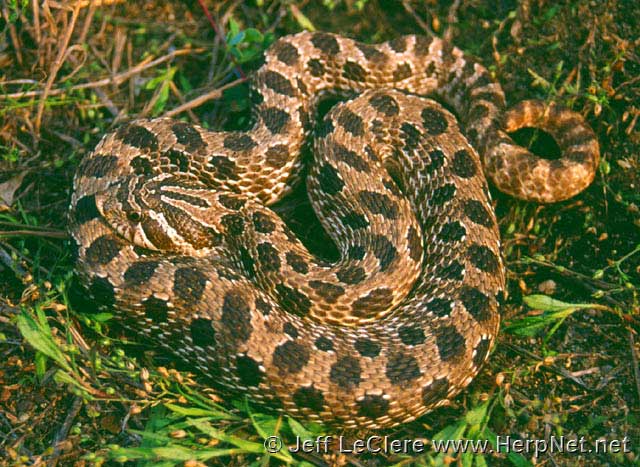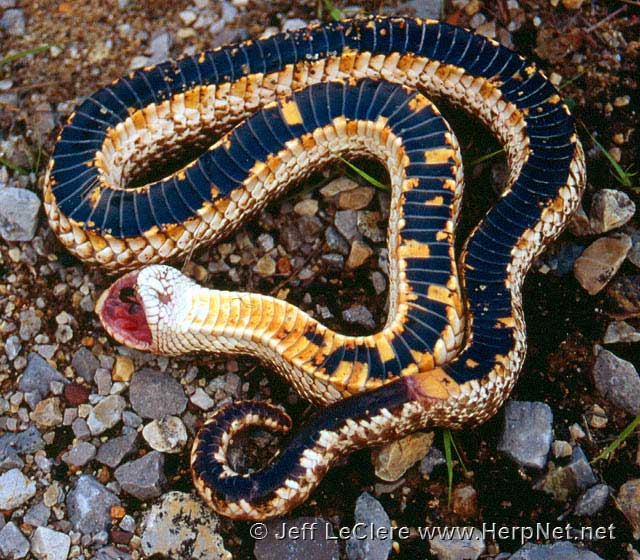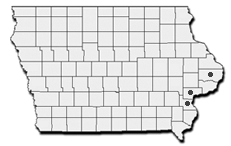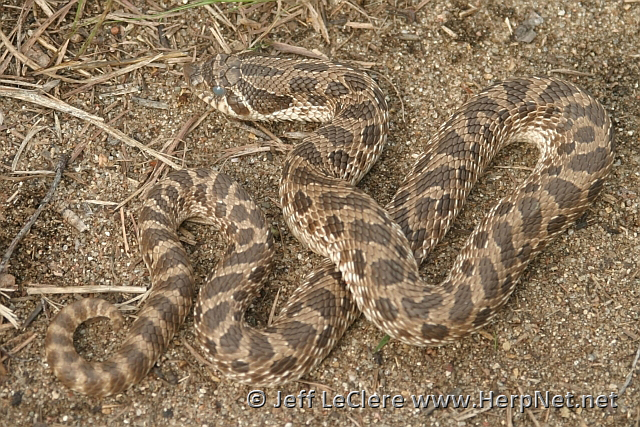Plains Hog-nosed Snake (Heterodon nasicus)
Alternate names: Plains Hognose Snake, Western Hognose Snake
by Jeff LeClere

Status
ENDANGERED and Species of Greatest Conservation Need. It is illegal to kill or collect this species by law in Iowa. Plains hog-nosed snakes need a special habitat to survive in Iowa. Unfortunately, most of that habitat is now gone. We really need records from the western part of Iowa! Please report sightings to us or the DNR.The former common name for this snake was western hog-nosed snake, or western hognose snake, and is still widely used by many people. Another name is plains hognose snake.
Description
Harmless to humans. This is a medium sized Iowa snake ranging from 15 to 39 inches in length. It is a very heavy-bodied serpent. It is harmless. The ground color is usually some shade of brown with darker brown blotches down the back. There are two alternating rows of smaller dark spots along the sides. There is a large longitudinal blotch on both sides of the neck. These blotches are brown, but not black. The belly is shiny jet black with small yellow or whitish squares, often many squares clustered together.

The anal plate is usually lighter colored than the belly. The underside of the tail is black. The rostral scale is enlarged; protruding outward and upward like a hog’s snout. The snout comes to a point and there is a heavy keel along the top. Plains hog-nosed snakes have smaller scales around their snouts. Other snake species, such as eastern hog-nosed snakes, rat snakes, and water snakes have no smaller scale separation; the prefrontals and internasals are all touching on the snout. The body scales are keeled and the anal plate is divided.
Subspecies
There are no subspecies of plains hog-nosed snake recognized.
Range

In Iowa, the plains hog-nosed snake has a very spotty distribution due mostly to a preference for a particular habitat and the result of habitat fragmentation and destruction. The sand prairies in which it lives are now very rare in Iowa. Populations may be found in the Mississippi Alluvial Plain. Past records indicate loss of populations in Iowa (Christiansen, 1998). If a specimen is found, contact us or the DNR.
Habitat
This snake has a strong preference for sandy or gravelly situations. Plain hog-nosed snakes like sand prairies, very open portions of prairies, or sand dunes with very little cover. Habitat destruction or other environmental changes may push this snake out of its natural habitat and force it to live in more wooded biomes; many simply will not adjust to these changes. This is how most populations are lost. They, like some other Iowa herps (LeClere, 1998), cannot adapt to changes that alter their strictly sandy habitats. See also range and habitat sections for the bullsnake and the ornate box turtle.
Habits
The plains hog-nosed snake is best known for is its method of protection. When confronted, it may remain still to blend in with its surroundings or it may hide its head under its coils. If discovered, the hog-nosed snake will spread its jaws and neck like a cobra while puffing up its body. This is one of the few Iowa snakes that actually hiss with great vigor; only the bullsnake rivals it. The hog-nosed snake will strike, but with a closed mouth! This behavior causes it to be called blow snake, spreading adder, hissing adder, or puff adder by local people. If this front fails and persecution persists, it will twist and turn as though in pain and then roll over on its back and play dead! With a wide open mouth and tongue hanging out, almost nothing can persuade it to move. Even if it is picked up, the serpent remains limp and lifeless. It may bleed from the mouth and cloaca and expel musk or fecal matter or even regurgitate recently eaten food. It closes off the opening to the esophagus and salivates. This is to prevent the swallowing of dirt and is readily observed in H. platirhinos. Only one thing gives the act away: if it is righted, it will immediately roll onto its back again. If left alone, the snake will crawl away and resume its activities. The eastern hog-nosed snake is quite a bit more eccentric with its act than the plains hog-nosed snake.
This species also may use its burrowing capabilities to escape. Using its upturned snout, it can burrow out of sight amazingly fast. The plains hog-nosed snake is diurnal except in very hot weather when they may aestivate. They are most active in the morning and evening. They may not use artificial cover as often as other snakes, as they sometimes use mammal burrows and can also construct temporary burrows themselves. On an 80 F. day in May in Hennepin County, MN, I found an adult in a burrow under a piece of tin. It was upside down and I suspect that it was thermoregulating utilizing the tin for ventral heat.
Plains hog-nosed snakes hibernate from September or October to March or April in mammal or other burrows. They breed in the spring and, perhaps more commonly than thought before, again in the fall. They are oviparous; laying anywhere from 2 to 30 or more eggs in a clutch with the most common number of eggs being somewhere in the middle of that range. The hatchlings are 5-8 inches when they hatch in August or September. The young are very similar in appearance to the adults.
Food
These snakes are voracious feeders and consume any smaller animals they find. Frogs, toads, lizards, small snakes, reptile eggs, ground-nesting bird eggs, rodents, and small birds. Carrion is also consumed and young snakes may apparently eat insects. I found an adult male in Louisa County on 5 July that had consumed two turtle eggs. Other authors have reported plains hog-nosed snakes feeding upon turtle eggs as well (Barten 1980, Iverson 1990, Kolbe 1999, Platt 1969). Plains hog-nosed snakes are not constrictors and simply swallow prey alive.
There is great controversy as to the venomous or toxic nature of North American hog-nosed snakes. Most often, bites produce no effects in humans, and medically significant or clinical bites from North American hog-nosed snakes are rare, produce only temporary local effects, and are usually caused by a feeding response in captive specimens. Most of the debate is perpetuated and complicated by the lack of agreement and/or understanding of various terms such as “venomous”, “toxicity”, “fangs”, “allergy”, etc. Though polemic, the vast majority of informed people agree that North American hog-nosed snakes should be considered harmless to humans.
